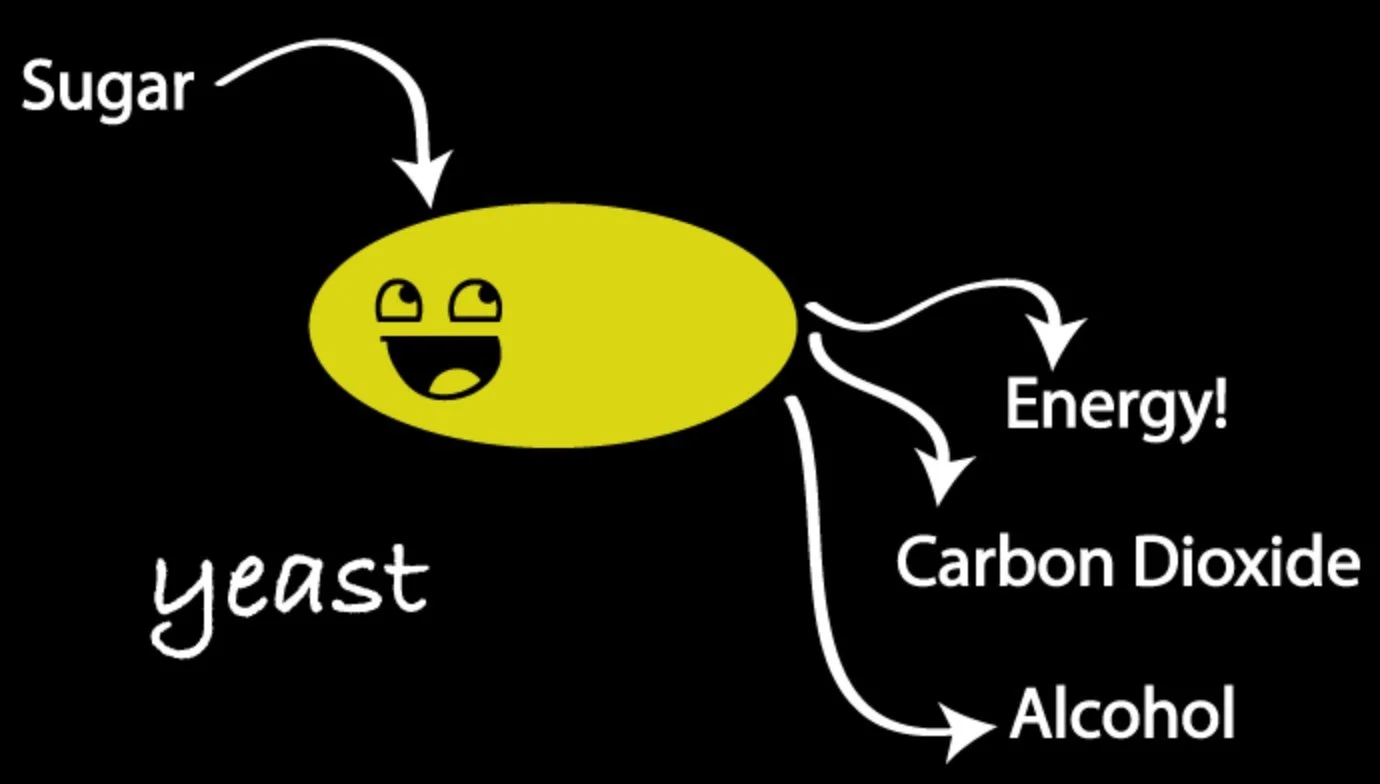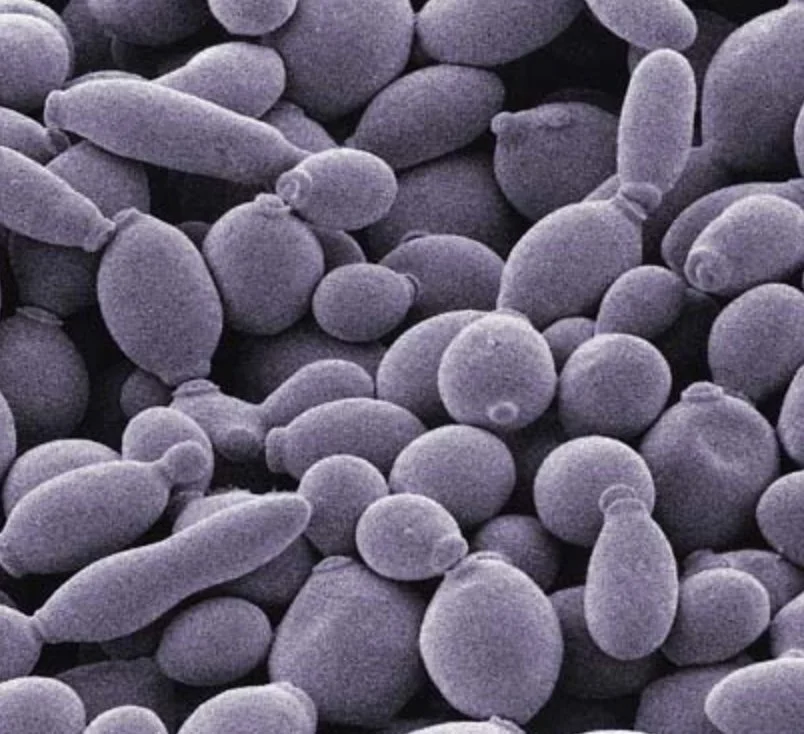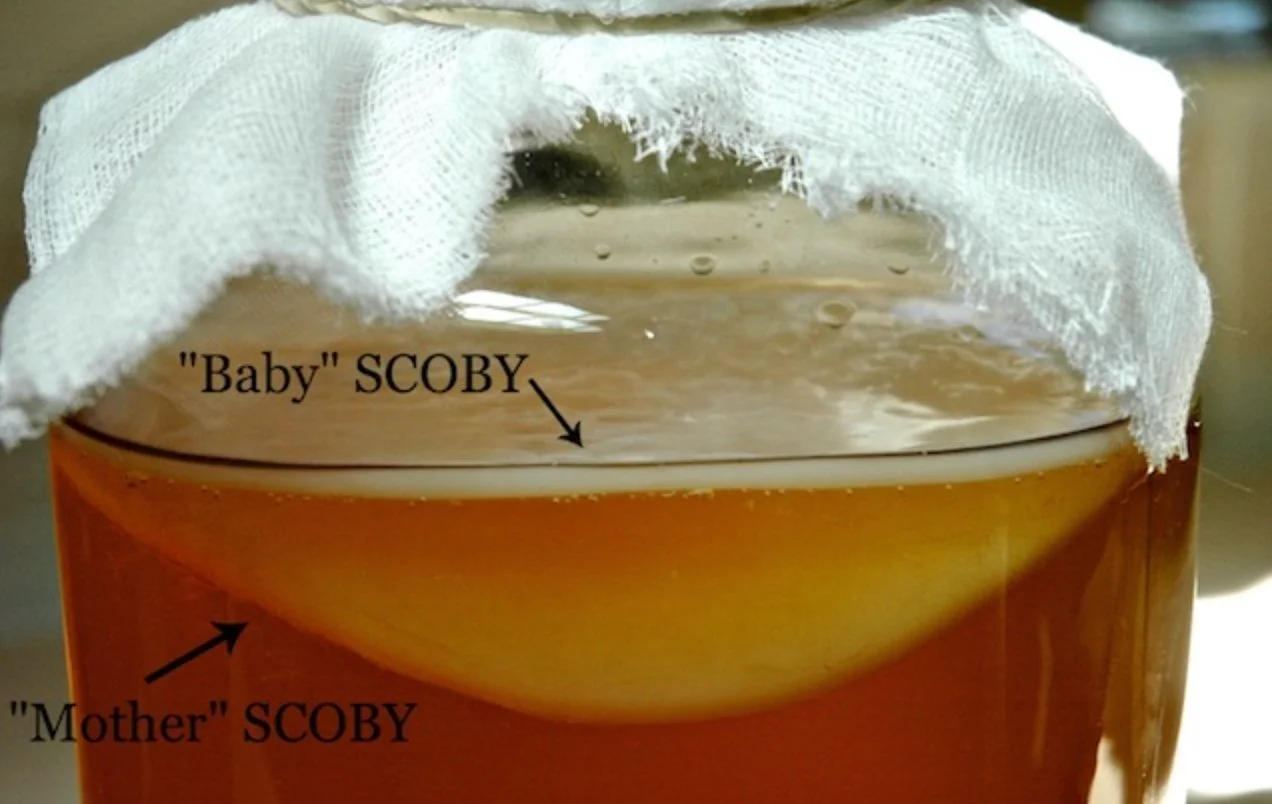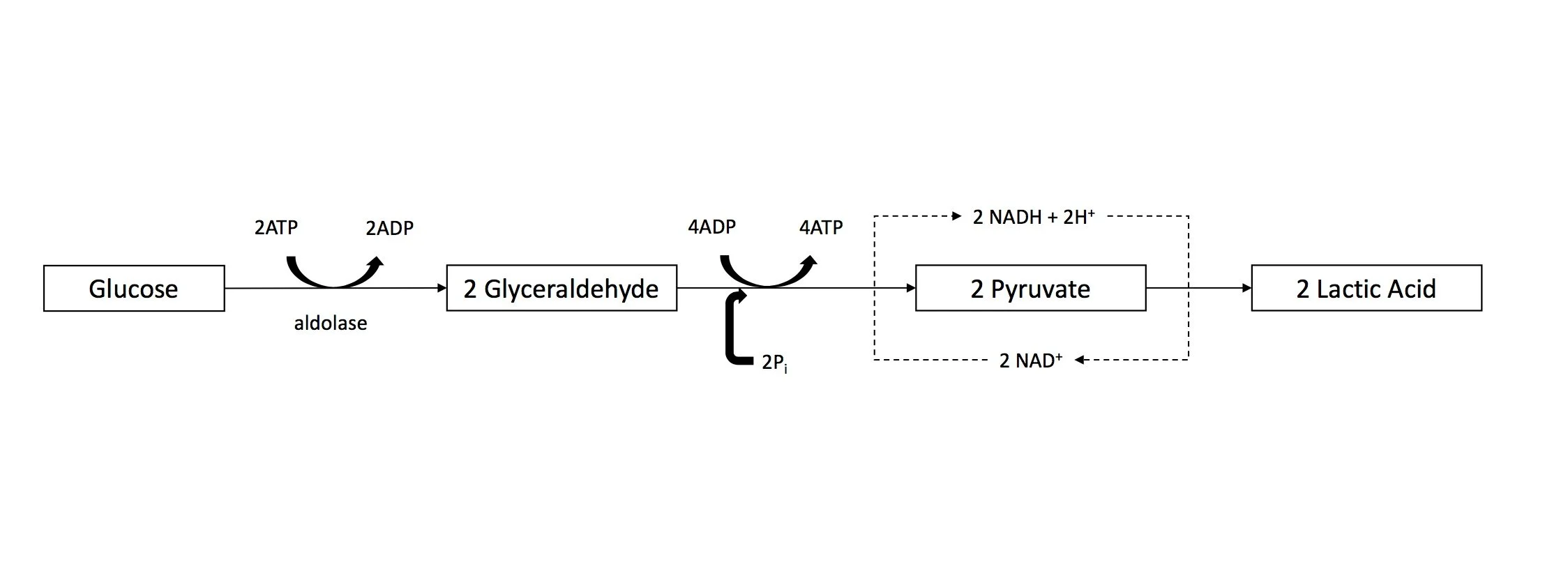The Low-Down on Fermented Tea, Part I: Kombucha Microbiology & Chemistry
Fermentation Essentials
First off - we love kombucha and we love fermentation. Even ants ferment grass! For those who need a wee lesson, or refresher, on fermentation, please follow the link. If you can’t be bothered just keep in mind that a fermentation typically involves the transformation of some sort of sugars, by microbes – bacteria and/or yeast – into metabolites, in the absence of oxygen. In order to begin this discussion, let’s define a “natural” fermentation. A natural fermentation implies that no single strain, or strains, of yeast or bacteria have been isolated by scientists (or apt DIY microbiology enthusiasts) and inoculated into the sugary substance before the yeast and bacteria which are naturally floating around in the air are able to invade it. This is analogous to naturally, or spontaneously, fermented beers which are still produced, most notably, in a small area within a few kilometers radius of Brussels; they are worth checking out.
As a contrast to a natural fermentation, most (beer) breweries throw a single strain of yeast cells into a sugary liquid immediately upon its production, and cooling, so as to avoid any uncontrolled, or foreign, microorganisms from getting in there and changing the desired outcomes. This was of course not the case before 1883, when Emil Christian Hansen, employed at the famous Carlsberg brewery laboratory in Copenhagen, became the first to isolate the a single-cell yeast culture. Hansen's breakthrough allowed for a new mass production of nearly identical beer over, and over, and over, again. In fact, they even named this species after the sponsoring company – Saccharomyces carlsbergensis. Thankfully, this name never stuck and it was officially named after Louis Pasteur (Saccharomyces pastorianus); as Hansen didn’t really even identified it as a separate species. Anyways, this species of yeast is actually what ferments your lagers! With differing strains, of course. The theory on the origin of how the species Saccharomyces pastorianus, and thus lager beers, came to be is quite interesting and it involves ships (maybe even pirates!) coming over to Germany from South America.
Commissioned by Napoleon III, the work by Pasteur on understanding yeast, air, and “germs” in Études sur le vin was quite remarkable for the time and resulted in the birth of industrial pasteurization. That was actually a pretty cool tangent, so maybe we’ll continue with the discussion of yeast. Yeast is actually a type of fungi and the word Saccharomyces has Latinized-Greek roots, meaning “sugar mushroom” or “sugar fungus”. Scientists use this name to identify a genus of yeast which are able to ferment various carbohydrates (sugars). For example, the species used to ferment ale is called Saccharomyces cerevisiae (Latin for beer).
Food for thought - Some say that yeast have become our slaves. We feed them and they do our biding and give us bread, alcohol, wine and beer; something that would be near impossible for us to do on such a scale, otherwise. However, a wise man once asked the opposite question – are we not their slaves? We feed them and take care of them and allow them to reproduce in the billions, while we consume their waste products.
Budding Yeast Cells
Some of which showing scars from “budding”, which is the most common form of yeast cell asexual reproduction, where a “daughter” cell breaks off from it’s “parent” cell, leaving a “budding scar" on the parent cell.
Kombucha
The History
Alright, so that tangent on beer might seem like useless and self-serving when considering the incipient discussion on fermented tea, but it is not. You will see.
Fermented tea (most often called kombucha or jun) looks nasty, tastes delicious, and is super easy to make. The results, and benefits, of fermenting tea will ultimately depend on the type of tea used, local microflora, sugar sources, as well as fermentation parameters (e.g. temperature, duration, water chemistry). Before diving into the potential health benefits behind fermented tea, we think it would be fun to explore the history behind the drink (take it with a grain of salt, but these “facts” have been published in several peer reviews scientific journals, which should mean more than what’s written about Samurai on the back of some of your kombucha bottles).
Kombucha is the common name given to a symbiotic growth of acetic acid bacteria, among others, and osmophilic yeast species in a zoogleal mat which is cultured in sugared tea, to which has been assigned the formal botanical name Medusomyces gisevii (1). Kombucha is the internationally used Germanized form of the Japanese name for fermented tea of this nature (1). The drink is thought to have originated in Manchuria (northeast China) during the Tsin Dynasty (~220 B.C.), where it was believed to impart detoxifying and energizing effects. Around the year 440 A.D., the physician Kombo was thought to have brought the tea fungus to Japan, where he used it to cure the digestive problems of Emperor Inkyo (1). From Japan, kombucha was thought to have made its way to Europe, through Russia. The way in which this migration happened is not clear, but it was likely a result of trade routes expanding throughout Russia, or as a result of the Russo-Japanese war. Russians referred to kombucha as “cainii kvass”, “Japonskigrib”, “kambucha”, “jsakvasska”, among other names. Kombucha then made its way into Germany at the turn of the 20th century and on into France, and France-occupied North Africa during World War II. A shortage of tea leaves following WW II led to a decline in kombucha consumption, until Italians began preparing it in larger numbers in the 1950’s, where it was called “funkochinese”.
How it's Made
Fermenting tea involves the infusion of tea leaves in sweetened water, followed by a subsequent natural fermentation. Here is a traditional recipe (1):
tap water (1 L) is boiled with 50 g sucrose stirred in
5 g tea leaves are added and removed after 5-10 min
after cooling to room temperature (20-30 C) the tea is inoculated with 24 g tea fungus (the culture) and poured into a beaker (1 L) previously sterilized with boiling water
2 L previously fermented kombucha is added, to hinder the growth of undesirable microorganisms by lowering the pH (many harmful bacteria cannot survive at low pH)
the beaker is covered with a paper towel to keep insects, especially Drosophila fruit flies, away
the incubation is carried out at 20 C-22 C (the optimal temperature is in the wide range of 18oC and 26oC)
Fermenting Kombucha
Different cellulose layers visible
This recipe, of course, assumes that one already has access to a “tea fungus”, or more commonly referred to as a “mother”, or SCOBY (Symbiotic Culture of Bacteria and Yeast) – let’s call it the mother.
In the next few days, the newly formed “baby” culture will start to float and form a clear thin gel-like membrane across the surface. The formation of this gel-like structure is gross, there’s no way around it. However, the way in which it is formed is absolutely beautiful. Tea fungus is not a mushroom. This association is wrongly made due to the ability of bacteria to synthesize a floating cellulose network (composed of secondary metabolites of the fermentation) which appears like surface mold on the undisturbed medium (2). The newly formed baby is available as a new layer above the mother.
At this time, the tea will start to smell fermented and there will be gas bubbles appearing from the carbonic acid produced during the fermentation (1). The mother layer will remain at its original volume as it sinks to the bottom of the tea broth where it remains under the newly forming baby culture. After 10 to 14 days, a new baby will have developed on the surface of the tea as a disc of maybe 1 or 2 cm thickness, covering the whole diameter of the container (3). The newly formed baby can be removed with a spoon and kept in a small volume of fermented tea, to give to a friend! At this point you can bottle the liquid inside the jar and cap the jars. You can introduce flavorings at this point, especially those possessing sugars, so as to ensure fermentation continues in the bottles; ensuring carbonation. The taste of the kombucha changes during fermentation from a pleasantly fruity sour-like flavor after a few days to a mild vinegar-like taste after a long fermentation period (may become too acidic - posing potential risks when consumed) (4). This recipe has been shown to provide an optimal concentrations of ethanol and lactic/acetic acid.
Yeasts and bacteria in kombucha are involved in such metabolic activities that utilize substrates by differing, and complementary, ways (1). Yeasts hydrolyze sucrose into glucose and fructose by invertase and produce ethanol via glycolysis; with a preference for fructose as a substrate (1). Acetic acid bacteria make use of glucose to produce gluconic acid, and ethanol to produce acetic acid. Similar pathways exist for lactic acid bacteria, leading to the production of lactic acid. The pH value of kombucha decreases due to the production of theses organic acids, as well as others, during fermentation (5).
Lactobacillus Biotransformation
At this point in the discussion we know more or less how kombucha is traditionally produced, and what the general attributes are in the final beverage. The end goal will be to explore what this means for the consumer who is looking for a beverage which they hope will impart that “energizing and detoxifying” effect that the ancient healers boasted. So, let’s look at the microbiology and chemical composition a bit more before introducing metabolism, proven benefits, and how to improve your kombucha fermentation, in Parts II - IV.
Microbial Composition
Similarly to milk-derived kefir, the exact microbial composition of kombucha cannot be given because it varies (1). This is very important to register. It depends on the source of the “natural” inoculum for the tea fermentation; which, of course, will vary based on geography, tea type, etc. The most abundant bacteria found in many kombucha cultures belong to the genera Acetobacter, Gluconobacter and Lactobacillus (e.g. Acetobacter xylinum, Acetobacter pasteurianus, Acetobacter aceti, Gluconobacter oxydans (6,7,8,9). In fact, as from the study of beer, several new bacterial species and strains have been isolated as a result of studying kombucha cultures (i.e. Acetobacter intermedius, Acetobacter nitrogenifigens, and the nitrogen-fixing, cellulose-producing Gluconacetobacter kombuchae) (10,11).
Similarly, a broad spectrum of yeasts have been reported including species of Saccharomyces, Saccharomycodes, Schizosaccharomyces, Zygosaccharomyces, Brettanomyces, Candida, Torulospora, Koleckera, Pichia, Mycotorula, and Mycoderma (9,12,13,14). In case you are wondering, yes, Saccharomyces cerevisiae (ale yeast) is commonly found in kombucha cultures! While we are acknowledging the relevance of our earlier divergence, to which we promised relevance, we should point out that several of the Brettanomyces strains found in kombucha are the same as those found in the “naturally” fermented beers surrounding Brussels (e.g. Brettanomyces bruxellenis). Similarly to the novel bacteria found, several new yeast species have been identified from studying kombucha (e.g. Zygosaccharomyces kombuchaensis) (15,16). .Of course, there are many other species, and genus, that have been identified in kombucha around the world, but these stated above tend to be some of the most prevalent.
Chemical Composition
Earlier, I eluded to some common organic acids found in kombucha. Organic acids are very important due to their impact on olfactory response and organoleptic qualities of food and drink. In fact, organic acids are commonly used in the food industry for flavoring (e.g. prepared salad dressings), with each imparting slightly different qualities. More importantly, in my opinion, they each tend to impact health in some way, be it nutritionally (e.g. ascorbic acid – vitamin C – helps in the absorption of iron), or in a preserving sense (i.e. lowering pH to keep harmful bacteria such as E. coli out of your food). Chemical analysis of kombucha shows the presence of various organic acids; namely acetic, gluconic, glucuronic, citric, L-lactic, malic, tartaric, malonic, oxalic, succinic, pyruvic. As well as the vitamins B1, B2, B6, B12 (1). You’ll also find amino acids, biogenic amines, purines, pigments, lipids, proteins, hydrolytic enzymes, ethanol, antibiotically active matter, carbon dioxide, tea polyphenols (act as antioxidants), minerals, and many more (1). That sounds good, in theory. What doesn’t sound good is the sugars left over; such as sucrose, glucose, and fructose. Sucrose is the most common carbon source in kombucha fermentation and a considerable amount stays largely unfermented during the process (roughly 35% of sucrose stays unfermented after 7 days, and roughly 20% after 21 days). In fact, it has been demonstrated that sucrose content linearly decreases during the first 30 days, followed by a slow-rate decline (17). Worry not, however, as we’ll look at how to lower that value in Part IV. You should now have a more thorough understanding of kombucha than most. Perhaps more so than you would like. The chemical analysis will really help to comprehend the potential health impacts and the improved fermentation sections in subsequent posts.
References
Jayabalan R, Malbaša RV, Lončar ES, Vitas JS, Sathishkumar M (2014) A review on kombucha tea—microbiology, composition, fermentation, beneficial effects, toxicity, and tea fungus. Comprehensive Reviews in Food Science and Food Safety13: 538-550
Nguyen NK, Nguyen PB, Nguyen HT, Le PH (2015) Screening the optimal ratio of symbiosis between isolated yeast and acetic acid bacteria strain from traditional kombucha for high-level production of glucuronic acid. LWT-Food Sci. Technol.64: 1149-1155
Mohammadshirazi A, Kalhor EB (2016) Energy and cost analyses of kombucha beverage production. Renew. Sust. Energ. Rev.55: 668-673
Sreeramulu G, Zhu Y, Knol W. 2000. Kombucha fermentation and its antimicrobial activity. J Agri Food Chem48:2589–94
Dufresne C, Farnworth E. 2000. Tea, kombucha, and health: a review. Food Res Int33:409–21
Danielova LT. 1957. K Himicheskomu sostavu I Physics-khemicheskim svoistvam kulturalnoi zhidkosti chainogo Gryb. Trudy Erevanskogo Zooveterinarngo Institute22:111–21
Konovalov IN, Semenova MN. 1955. K Fiziologii “Cajnogo Griba”. Bot Zˇurnal(Moscow) 40:567–70
Sievers M, Lanini C, Weber A, Schuler-Schmid U, Teuber M. 1995. Microbiology and fermentation balance in a kombucha beverage obtained from a tea fungus fermentation. Syst Appl Microbiol18: 590-4
Liu CH, Hsu WH, Lee FL, Liao CC. 1996. The isolation and identification of microbes from a fermented tea beverage, Haipao, and their interactions during Haipao fermentation. Food Microbiol13:407–15
Boesch T,Trcêek J,Sievers M,Teuber M. 1998. Acetobacter intermedius, sp. nov. Syst Appl Microbiol21:220–9
Dutta D, Gachhui R. 2006. Novel nitrogen-fixing Acetobacter nitrogenifigens sp. nov., isolated from kombucha tea. Int J Syst Evol Microbiol56:1899–903
Herrera T, Calderon-Villagomez A. 1989. Species of yeasts isolated in Mexico from the tea fungus. Rev Mex Micol5:205–10
Markov SL, Malbaˇsa RV, Hauk MJ, Cvetkovic ́ DD. 2001. Investigation of tea fungus microbe associations. The yeasts. Acta Period Technol32:133–8
Safak S, Mercan N, Aslim B, Beyatli Y. 2002. A study on the production of poly-beta-hydroxybutyrate by some eukaryotic microorganisms. Turk Electron J Biotechnol Special issue 11–7
Kurtzman CP, Robnett CJ, Basehoar-Powers E. 2001. Zygosaccharomyces kombuchaensis, a new ascosporogenous yeast from “kombucha tea”. FEMS Yeast Res1:133–8
Steels H, James SA, Bond, CJ, Roberts IN, Straford M. 2002. Zygosaccharomyces kombuchaensis: the physiology of a new species related to the spoilage yeasts Zygosaccharomyces lentus and Zygosaccharomyces bailii. FEMS Yeast Res2:113–21
Chen C, Liu BY. 2000. Changes in major components of tea fungus metabolites during prolonged fermentation. J Appl Microbiol89:834–9




